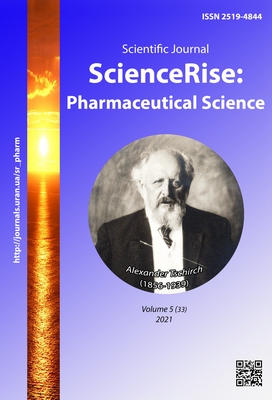Structural modification of ciprofloxacin and norfloxacin for searching new antibiotics to combat drug-resistant bacteria
DOI:
https://doi.org/10.15587/2519-4852.2021.242997Keywords:
fluoroquinolones, ciprofloxacin, norfloxacin, synthesis, antibiotic resistance, molecular docking, antibacterial activityAbstract
The aim of the work. Among all the representatives of four generations of fluoroquinolones ciprofloxacin (CIPRO) and norfloxacin (NOR) remain widely used and prescribed antibiotics in clinical practice. However, the problem of resistance towards them is gradually increasing. Thus, our investigation is dedicated to chemical modification of C-7 position of Ciprofloxacin and Norfloxacin ring as a promising solution to combat antibiotic resistance and open a pathway towards convenient synthesis of new fluoroquinolones derivatives.
Materials and methods. The subjects of the research were N-piperazine-substituted ciprofloxacin and norfloxacin. The methods of molecular docking and organic synthesis were applied in the study. The structures of the obtained compounds were confirmed by 1H NMR, 13C NMR, 19F NMR, LC/MS, IR, UV spectroscopy. The antimicrobial activity was measured by the method of double serial dilutions against Staphylococcus aureus (ATCC 25923), Escherichia coli (ATCC 25922), Bacillus subtilis (ATCC 6633), Pseudomonas aeruginosa (ATCC 27853), Candida albicans (NCTC 885-653) and diffusion in agar method against clinical strains.
The results. 7-(4-(2-Cyanoacetyl)piperazin-1-yl)-1-R-6-fluoro-4-oxo-1,4-dihydroquinoline-3-carboxylic acids were synthesized and their structures were confirmed. The obtained compounds showed the antibacterial activity on the reference level for double dilution method and exceeded control for “well” method.
Conclusions. The current investigation revealed the promising route for the expanding of the existing fluoroquinolones diversity. Pharmacodynamics and pharmacokinetics changes could be achieved by chemical modifications of C-7 position of the initial ring. Further research utilizing the obtained compounds as starting ones opens a promising way to novel active molecules synthesis and combating the problem of antibiotic resistance
References
- The evolving threat of antimicrobial resistance. Options for action. WHO. Available at: http://apps.who.int/iris/bitstream/handle/10665/44812/9789241503181_eng.pdf?sequence=1
- Polk, R. E., Fox, C., Mahoney, A., Letcavage, J., MacDougall, C. (2007). Measurement of Adult Antibacterial Drug Use in 130 US Hospitals: Comparison of Defined Daily Dose and Days of Therapy. Clinical Infectious Diseases, 44 (5), 664–670. doi: http://doi.org/10.1086/511640
- Birnbaum, D. (2003). Resistance CCoA. Antimicrobial resistance: a deadly burden no country can afford to ignore. Canada Communicable Disease Report, 29 (18), 157–164.
- Feshchenko, Yu. I., Humeniuk, M. I., Denysov, O. S. (2010). Antybiotykorezystentnist mikroorhanizmiv. Stan problemy ta shliakhy vyrishennia. Ukrainskyi khimioterapevtychnyi zhurnal, 1-2 (23), 4–10.
- Suaifan, G. A. R. Y., Mohammed, A. A. M. (2019). Fluoroquinolones structural and medicinal developments (2013–2018): Where are we now? Bioorganic & Medicinal Chemistry, 27 (14), 3005–3060. doi: http://doi.org/10.1016/j.bmc.2019.05.038
- Bush, N. G., Diez-Santos, I., Abbott, L. R., Maxwell, A. (2020). Quinolones: Mechanism, Lethality and Their Contributions to Antibiotic Resistance. Molecules, 25 (23), 5662. doi: http://doi.org/10.3390/molecules25235662
- Dalhoff, A. (2012). Global Fluoroquinolone Resistance Epidemiology and Implictions for Clinical Use. Interdisciplinary Perspectives on Infectious Diseases, 2012, 1–37. doi: http://doi.org/10.1155/2012/976273
- Fasugba, O., Gardner, A., Mitchell, B. G., Mnatzaganian, G. (2015). Ciprofloxacin resistance in community- and hospital-acquired Escherichia coli urinary tract infections: a systematic review and meta-analysis of observational studies. BMC Infectious Diseases, 15 (1). doi: http://doi.org/10.1186/s12879-015-1282-4
- Savchenko, T. I., Silin, O. V., Kovalenko, S. M., Musatov, V. I., Nikitchenko, V. M., Ivachtchenko, A. V. (2007). Alkylation of 3‐Phenyl‐1H‐pyrazolo[4,3‐c] quinoline: Theoretical Analysis of Regioselectivity. Synthetic Communications, 37 (8), 1321–1330. doi: http://doi.org/10.1080/00397910701227077
- Ivachtchenko, A., Silin, O., Savchenko, T., Kovalenko, S., Nikitchenko, V. (2004). Synthesis of 5H-Pyrazolo[4,3-c]quinolines. Heterocycles, 63 (8), 1883–1890. doi: http://doi.org/10.3987/com-04-10092
- Bylov, I. E., Bilokin, Y. V., Kovalenko, S. M. (1999). Specific Features of Reactions of 2-Aminobenzotrifluoride and Anthranilates with Ethyl Cyanoacetate – Expeditious Routes to 3-Substituted 4-Amino- and 4-Hydroxyquinolin-2(1H)-Ones. Heterocyclic Communications, 5 (3). doi: http://doi.org/10.1515/hc.1999.5.3.281
- Naidu, K. M., Nagesh, H. N., Singh, M., Sriram, D., Yogeeswari, P., Gowri Chandra Sekhar, K. V. (2015). Novel amide and sulphonamide derivatives of 6-(piperazin-1-yl)phenanthridine as potent Mycobacterium tuberculosis H37Rv inhibitors. European Journal of Medicinal Chemistry, 92, 415–426. doi: http://doi.org/10.1016/j.ejmech.2015.01.013
- Black, T. A., Mcnicholas, P. M., Walker, S. S., Xu, Y., Ting, P. C. (2008). Pat. WO2008115385A2. Piperazine-substituted pyridazinone derivatives useful as glucan synthase inhibitors. Available at: https://patents.google.com/patent/WO2008115385A2/en
- Pushpan, S., Ramachandran, U., Kundu, M., Anantharaman, V., Subramanian, S., Viswanathan R., Tadiparthi, R. et. al. (2008). Novel compounds and their use. Pat. WO2009001192A2. Available at: https://patents.google.com/patent/WO2009001192A2/en
- Mohapatra, R. K., El-ajaily, M. M., Alassbaly, F. S., Sarangi, A. K., Das, D., Maihub, A. A. et. al. (2020). DFT, anticancer, antioxidant and molecular docking investigations of some ternary Ni(II) complexes with 2-[(E)-[4-(dimethylamino)phenyl]methyleneamino]phenol. Chemical Papers, 75 (3), 1005–1019. doi: http://doi.org/10.1007/s11696-020-01342-8
- Mohapatra, R. K., Perekhoda, L., Azam, M., Suleiman, M., Sarangi, A. K., Semenets, A. et. al. (2021). Computational investigations of three main drugs and their comparison with synthesized compounds as potent inhibitors of SARS-CoV-2 main protease (Mpro): DFT, QSAR, molecular docking, and in silico toxicity analysis. Journal of King Saud University – Science, 33 (2), 101315. doi: http://doi.org/10.1016/j.jksus.2020.101315
- Volianskyi, Yu. L., Hrytsenko, I. S., Shyrobokov, V. P. (2004). Vyvchennia spetsyfichnoi aktyvnosti protymikrobnykh likarskykh zasobiv. Kyiv: DFTs MOZ Ukrainy, 38.
- Vyznachennia chutlyvosti mikroorhanizmiv do antybakterialnykh preparativ (2007). Metodychni vkazivky, 70.
- Sheldon, R. A. (2012). Fundamentals of green chemistry: efficiency in reaction design. Chemical Society Reviews, 41 (4), 1437–1451. doi: http://doi.org/10.1039/c1cs15219j
- Sheldon, R. A. (2019). The greening of solvents: Towards sustainable organic synthesis. Current Opinion in Green and Sustainable Chemistry, 18, 13–19. doi: http://doi.org/10.1016/j.cogsc.2018.11.006
Downloads
Published
How to Cite
Issue
Section
License
Copyright (c) 2021 Halyna Hryhoriv, Illia Mariutsa, Sergiy M. Kovalenko, Lyudmila Sidorenko, Lina Perekhoda, Nataliia Filimonova, Olga Geyderikh, Victoriya Georgiyants

This work is licensed under a Creative Commons Attribution 4.0 International License.
Our journal abides by the Creative Commons CC BY copyright rights and permissions for open access journals.








